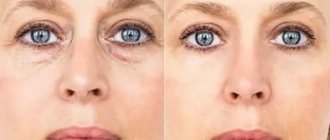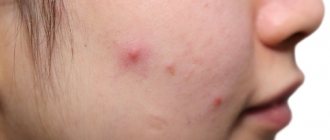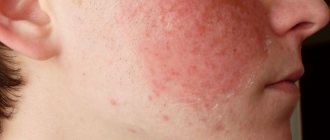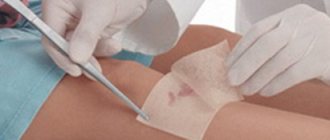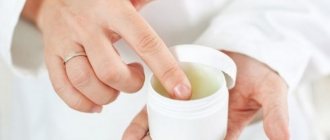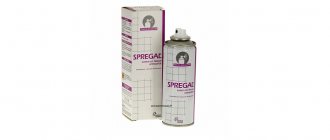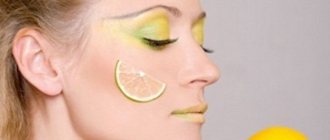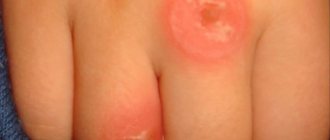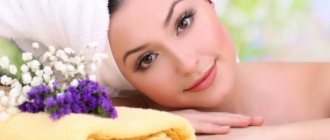Ovante cream for rosacea is a therapeutic and prophylactic agent that eliminates redness and inflammation on the skin of the face. The drug is effective for rosacea, acne and other skin diseases that are accompanied by rash and hyperemia. High-quality natural ingredients of the cream restore the skin and neutralize inflammation.
Acne, acne and pimples are diseases that are characteristic of the problematic type of epidermis. Most often, acne occurs during adolescence, when metabolism and the functioning of the endocrine system are restructured.
Teenagers need to choose a complex of cosmetics for facial care and medicinal anti-inflammatory drugs.
For those with problem skin, we recommend contacting a specialist - a cosmetologist or dermatologist. The doctor will determine the cause of the rash and prescribe appropriate treatment.
To get results from treatment, it is important to use rosacea creams and ointments correctly. Before you start applying the product, you need to read the instructions and follow the recommendations prescribed by your doctor.
Any product should be used only on clean skin. As a rule, the cream is applied twice a day: before bed and under makeup.
The average course of treatment is a month or one and a half. With rapid improvement, application is reduced to one time, but gradually. Can be used as maintenance therapy for 2 - 3 months.
Operating principle
Ovante cream is an effective remedy for rosacea, rashes and inflammatory processes. It normalizes the functionality of the epidermis, restores its health and attractive appearance.
The principle of action of Ovante cream:
- Provides anti-inflammatory, antimicrobial and disinfectant effects;
- Dries the skin, cleanses and tightens pores, eliminates blackheads;
- Improves the protective properties of the epidermis and restores the lipid layer of the skin;
- Normalizes metabolic processes and the functioning of small vessels;
- Soothes irritation and reduces the severity of acne;
- Rejuvenates the skin and triggers the renewal of damaged epidermal cells;
- Activates the immune defense of the skin to resist various irritants;
- Improves cell nutrition;
- Contains natural effective ingredients that meet the needs of problematic skin;
- It is well absorbed, does not leave a greasy residue, and does not clog pores.
Ovante cream is indicated for skin diseases:
- Rosacea;
- Acne and acne;
- Boils;
- Acne;
- Inflammatory processes.
Ovante cream has a contraindication - individual intolerance to the components. Before applying the drug, do a skin test. This will help prevent an allergic reaction.
Rosacea
Rosacea is a chronic inflammatory skin disease that tends to affect a highly visible area of the skin such as the face. The cosmetic symptoms of rosacea can be significant and can significantly reduce a patient's quality of life. Although there is no definitive cure for rosacea, effectively treating symptoms can reduce the harmful effects of the condition and improve your quality of life. In this article, we will review existing and new cosmetic treatments for rosacea, including topicals, systemic pharmacological treatments, light therapy techniques, and other modalities, and evaluate their ability to improve the cosmetic symptoms of rosacea. Since there is no definitive cure for rosacea, effective treatment is aimed at improving cosmetic symptoms. The choice of therapy should be determined on an individual basis, taking into account the clinical features of greatest concern to the patient. A combination of techniques and/or graded therapy is often required to achieve optimal cosmetic results. Rosacea is a chronic inflammatory skin condition that affects approximately 16 million Americans. Dermatosis most often affects the central part of the face (forehead, cheeks, nose, chin). The pathophysiology of rosacea remains poorly understood despite the relatively high prevalence of the disease and a significant portion of current research devoted to this dermatosis. Modern theory suggests the involvement of the innate and adaptive immune system, disorders of neurovascular regulation, changes in the blood and lymphatic vessels, genetic predisposition and the reproduction of synanthropic organisms, such as Demodex, in the pathogenesis of rosacea. In addition, the clinical course can be worsened by a variety of external factors, such as UV radiation, heat exposure, spicy foods, alcohol, and stress. The diagnosis of rosacea is usually made clinically and rarely requires histological confirmation. Although rosacea can present with a wide range of clinical features, its main feature is diffuse erythema of the central face. This centrofacial redness can intensify during periods of exacerbation and becomes persistent over a long period of time. Other signs of rosacea include telangiectasia, swelling, plaques, phymatous changes, dry skin, ocular manifestations and inflammatory lesions in the form of papules and pustules. Patients may also complain of a burning sensation in the areas of the skin lesions. Rosacea is classified into 4 subtypes: erythematotelangiectatic, papular-pustular, phymatous, ocular, and one variant, granulomatous. This division is conditional, because One patient may exhibit signs of several subtypes. Compared with the general population, patients with rosacea are more likely to have low self-esteem, embarrassment, social anxiety, and depression. However, effective treatment can improve cosmetic appearance and mitigate the negative psychological consequences of the disease. In the treatment of rosacea, topical and systemic medications, light methods, and various procedures are used. The selection of therapy should be carried out on an individual basis, taking into account clinical characteristics, using combined or sequential treatment methods.
Compound
All components of the cream specifically affect various imperfections of the problematic epidermis.
Ovante cream contains:
- Pharmaceutical sulfur in the form of small capsules has a vasoconstrictor effect, eliminates redness and forms the stratum corneum of the epidermis. Sulfur has antiparasitic properties and neutralizes pathogens that cause skin diseases.
- Salicylic acid is a component used in cosmetics for problem skin. It has antiseptic, healing, antibacterial and keratolytic properties.
- Zinc oxide is an ingredient that has a disinfecting and drying effect. It eliminates inflammatory processes and reduces the severity of acne.
- Azelaic acid is a component that has anti-inflammatory properties. It normalizes the production of lipids necessary to protect the skin, and also eliminates acne and its manifestations.
- Walnut oil is a natural ingredient that normalizes the functioning of the epidermal barrier.
- Tea tree oil is a natural component that has an antiseptic effect. It eliminates foci of inflammation and carefully cares for problematic skin.
- Black currant seed oil activates the protective properties of the skin and normalizes the functioning of the skin barrier function.
- Chamomile extract has soothing, brightening and toning properties. The component is indispensable for problematic epidermis. It effectively restores cell health and the appearance of the skin.
- Vitamin complexes have a strengthening effect. They strengthen the skin's immune defense and also slow down the aging process.
Basic treatment for rosacea
The pathogenesis of the disease has not yet been fully studied. Rosacea appears mainly on the face: cheeks, nose, forehead or chin, sometimes rosacea affects a large part of the face. In this case, acne is accompanied by inflammation and vascular so-called “stars”.
In this case, the appearance becomes unaesthetic, which clearly affects the psychological state of the patient; moreover, it is extremely difficult to mask the manifestations of rosacea with the help of foundation and other cosmetics.
Treatment must be comprehensive and include:
- medications: topical creams, ointments and gels;
- special diet;
- compresses;
- cosmetic procedures;
- in rare cases, antibiotics.
The prescription of drugs for the treatment of rosacea is influenced by: the patient’s age, course of the disease, tolerance of the components, emotional state and other factors. Regardless of this, everyone without exception is recommended to adhere to a diet, excluding from the diet:
- animal fats;
- smoked meats;
- alcohol;
- hot and spicy dishes;
- too hot food.
Another important recommendation is to avoid temperature changes and heat. It is necessary to avoid: saunas, steam baths, solariums, try not to go outside in extreme heat and not be under the scorching sun. In winter, you should cover your face from the frost.
If rosacea progresses to the second stage, characterized by pustules, antibacterial drugs will be required to relieve inflammation. In situations where abscesses or rhinophyma occur, their removal is only possible through surgery.
After contacting a specialist, he first of all prescribes external remedies. Read below on how to choose the right cream for rosacea. You can read about laser treatment for rosacea here.
Instructions for use
Read the instructions for using Ovante cream:
- Prepare your skin - it should be clean and dry. For problem skin, cleansing is an important step in skin care. The effectiveness of treatment and the health of the epidermis depend on the cleanliness of the facial skin.
- Apply the product in a thin layer, distributing with light massaging movements. If acne is localized on the face, you can apply the cream only to the area of the rash.
- The frequency of use of the product is 2-3 times a day.
- Patients with dry skin are recommended to use the cream once a day, gradually increasing the number of applications.
- Use the product regularly in combination with other products to care for problem skin.
Diagnostics
An experienced doctor can easily identify rosacea just by looking at the patient, especially when there are characteristic manifestations of nasal pineal or if the disease is advanced. Modern dermatology can clarify the patient’s diagnosis based on the data that the doctor receives, with the necessary studies of the intestines, blood vessels, laboratory blood tests and microparticles taken from reddened skin.
In order to make a correct diagnosis and prescribe treatment, you should consult a dermatologist. The specialist will perform a visual examination, a survey, from which he will learn about chronic pathologies of the body and the drugs used, and will also prescribe a set of examinations that will help determine the root cause of the disease.
Examinations:
- clinical blood test;
- lipid profile;
- a comprehensive blood test to assess the functioning of internal organs;
- ANA profile, for the presence of immunological diseases;
- extended hemostasiogram;
- Demodex analysis;
- bacteriological examination of the skin.
Based on the above examinations, the dermatologist makes a diagnosis and prescribes treatment.
Why does sulfur ointment help with acne, blemishes, demodicosis and rosacea?
Briefly about the main properties of sulfur ointment:
- Antiseptic and bacteriostatic action is the main strength of sulfur ointment . The ointment suppresses reproduction and destroys microbes and parasites, both on the surface and in the deeper layers of the skin.
- Anti-inflammatory property . The ointment soothes the skin and neutralizes inflammation.
- Stimulating rapid healing and regeneration of the skin is the reason for using sulfur ointment for spots, scars and acne marks (post-acne). The ointment reduces the size and color intensity of scar tissue.
- Sulfur ointment has a good drying effect . A great surprise for those with oily skin.
- Sulfur ointment perfectly fights fungi and parasites .
At the same time, the price of the ointment is simply ridiculous: you can buy sulfur ointment for only 30-50 rubles.
By the way, a worthy competitor to sulfur ointment is YAM BK ointment for acne. I recommend reading the article at the link.
Sulfur ointment for acne, blackheads and demodicosis: reviews
Why not try it! In complex therapy, sulfur ointment is quite effective.
Having read reviews about the results of using sulfur ointment for acne, blackheads and demodicosis, we can say that the product is worthy and helps many people a lot. In especially vivid reviews, you can find confirmation that sulfur ointment can help even when expensive means do not help .
I will say in advance that you should not expect lightning-fast healing, but a slight improvement in the condition of the skin will be noticeable within the first week of treatment. Be patient and go ahead! And finally - a little feedback from our readers in the comments, and also leave your point of view below!
General information
Rosacea is a non-infectious skin pathology that is typical for women over 45 years of age. Men get sick 2 times less often, however, they tolerate the disease more difficult. Children are almost never given this diagnosis. Patients with light, sensitive skin are at risk. The exact cause influencing the progression of the pathology has not been studied to date. Based on clinical studies, only assumptions have been made about the factors that can lead to the appearance of rosacea:
- Infections. When bacteria enter open wounds on the face, the risk of developing rosacea increases.
- Weak immunity. Weak functioning of the immune system leads to changes in the condition of the skin. This provokes the progression of rosacea.
- Genetic factor.
Malfunctions of the thyroid gland can lead to the formation of rosacea. Problems with metabolism, hormonal imbalance, impaired metabolism - all these factors provoke the development of an inflammatory process on the skin. The pathology is often confused with rosacea, however, these diseases are different in nature. Their difference lies in the intensity of symptoms. Rosacea needs to be treated comprehensively using medications, local and folk therapy. It is worth noting that the disease is not contagious to others.
